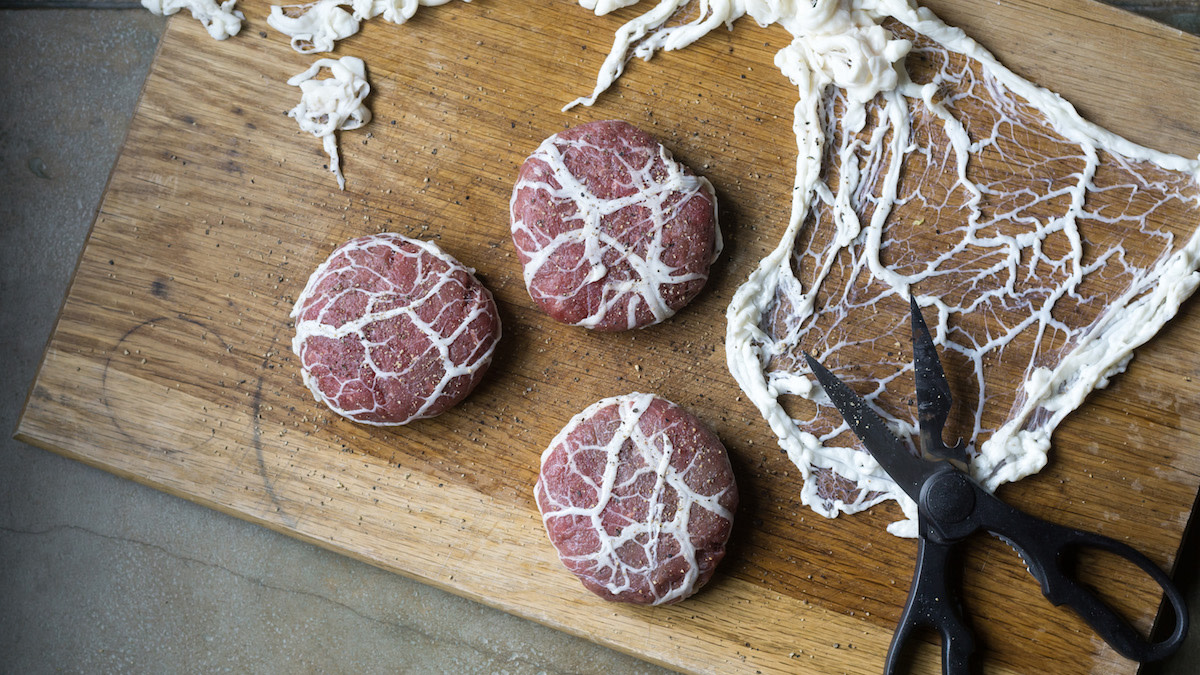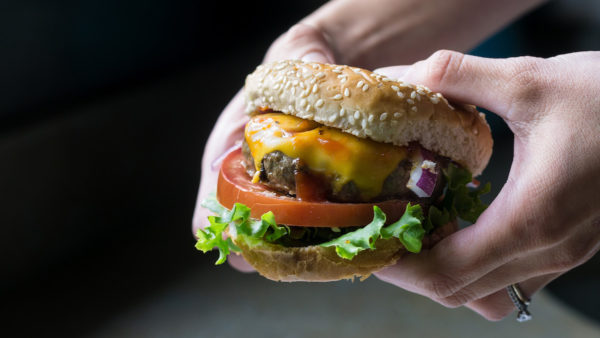
Duration
30 minutes
Serves
8
Most wild game enthusiasts probably have a favorite way to craft venison burgers that hasn’t been updated in a while. If you have a solid, go-to recipe for deer patties, it’s hard to blame you for not messing with it. However, I’d strongly suggest adding a new ingredient to your recipe: caul fat.
In a recent article, I covered what caul fat is and how to use it. If you’re not familiar, caul is a web of lacy fat found inside the abdomen of ungulates which can be used as a casing to impart lean meat with juicy flavor. This is the perfect opportunity to add wild fat to your game. As it grills, the fat melts and bastes the ground venison.
The caul fat from one deer should be enough to wrap about eight burgers. You want to use the thin web in the center, not the thick outer portions because it takes much longer to render. This will prevent the development of a chewy texture when biting into the burger.
It’s best to make the patties small and fat instead of wide and thin. You need time for the caul fat to render and crisp up, and a thick patty avoids overcooking the center.
The recipe below explains how to use caul fat for a simple, all-American burger. Feel free to adapt this to your liking and use your favorite toppings.
Ingredients
- Caul fat from one deer
- 2 pounds ground venison (10-20% fat added)
- Salt and pepper
- 8 hamburger buns
- 8 slices of cheese
- Toppings: red onion, lettuce, tomato, pickle, ketchup, mustard, mayo
Preparation
- Soak the caul fat in a bowl of lukewarm water to soften.
- Portion the venison into 8 servings and form them into small, thick patties.
- Lay the caul fat flat on a cutting board and pat dry with paper towels. Use scissors to cut small square portions of caul fat. Lay each patty down in the center and wrap it up like a package. It should stick to the meat, but if not, you can dip your fingertips in cold water and gently press the seams together. Use only enough caul fat to wrap around the patty once. If you wrap multiple layers it will take longer to render, risking an overcooked burger.
- Season each patty with salt and pepper.
- Preheat a grill or burn charcoal down to hot coals. Push the coals to the side so you have an area to move the patties off the direct heat if needed. Grill on each side for about 5 minutes or until cooked to desired doneness. The thicker the patties, the longer they will take to cook to the center. At that point, the outside edges should have a nice char from the caul fat rendering out. Lay a slice of cheese down on each patty, close the lid and cook until it melts.
- Serve with your choice of toppings.
Sign In or Create a Free Account
Reviews
Most wild game enthusiasts probably have a favorite way to craft venison burgers that hasn’t been updated in a while. If you have a solid, go-to recipe for deer patties, it’s hard to blame you for not messing with it. However, I’d strongly suggest adding a new ingredient to your recipe: caul fat.
In a recent article, I covered what caul fat is and how to use it. If you’re not familiar, caul is a web of lacy fat found inside the abdomen of ungulates which can be used as a casing to impart lean meat with juicy flavor. This is the perfect opportunity to add wild fat to your game. As it grills, the fat melts and bastes the ground venison.
The caul fat from one deer should be enough to wrap about eight burgers. You want to use the thin web in the center, not the thick outer portions because it takes much longer to render. This will prevent the development of a chewy texture when biting into the burger.
It’s best to make the patties small and fat instead of wide and thin. You need time for the caul fat to render and crisp up, and a thick patty avoids overcooking the center.
The recipe below explains how to use caul fat for a simple, all-American burger. Feel free to adapt this to your liking and use your favorite toppings.
Ingredients
- Caul fat from one deer
- 2 pounds ground venison (10-20% fat added)
- Salt and pepper
- 8 hamburger buns
- 8 slices of cheese
- Toppings: red onion, lettuce, tomato, pickle, ketchup, mustard, mayo
Preparation
- Soak the caul fat in a bowl of lukewarm water to soften.
- Portion the venison into 8 servings and form them into small, thick patties.
- Lay the caul fat flat on a cutting board and pat dry with paper towels. Use scissors to cut small square portions of caul fat. Lay each patty down in the center and wrap it up like a package. It should stick to the meat, but if not, you can dip your fingertips in cold water and gently press the seams together. Use only enough caul fat to wrap around the patty once. If you wrap multiple layers it will take longer to render, risking an overcooked burger.
- Season each patty with salt and pepper.
- Preheat a grill or burn charcoal down to hot coals. Push the coals to the side so you have an area to move the patties off the direct heat if needed. Grill on each side for about 5 minutes or until cooked to desired doneness. The thicker the patties, the longer they will take to cook to the center. At that point, the outside edges should have a nice char from the caul fat rendering out. Lay a slice of cheese down on each patty, close the lid and cook until it melts.
- Serve with your choice of toppings.








